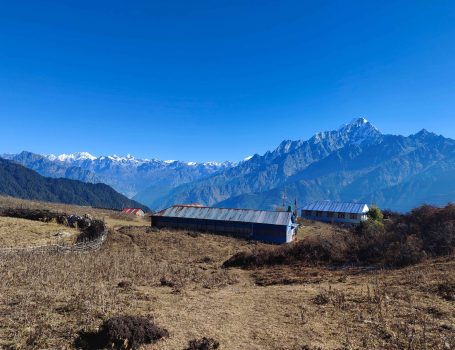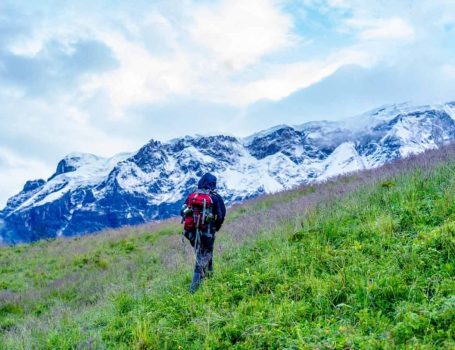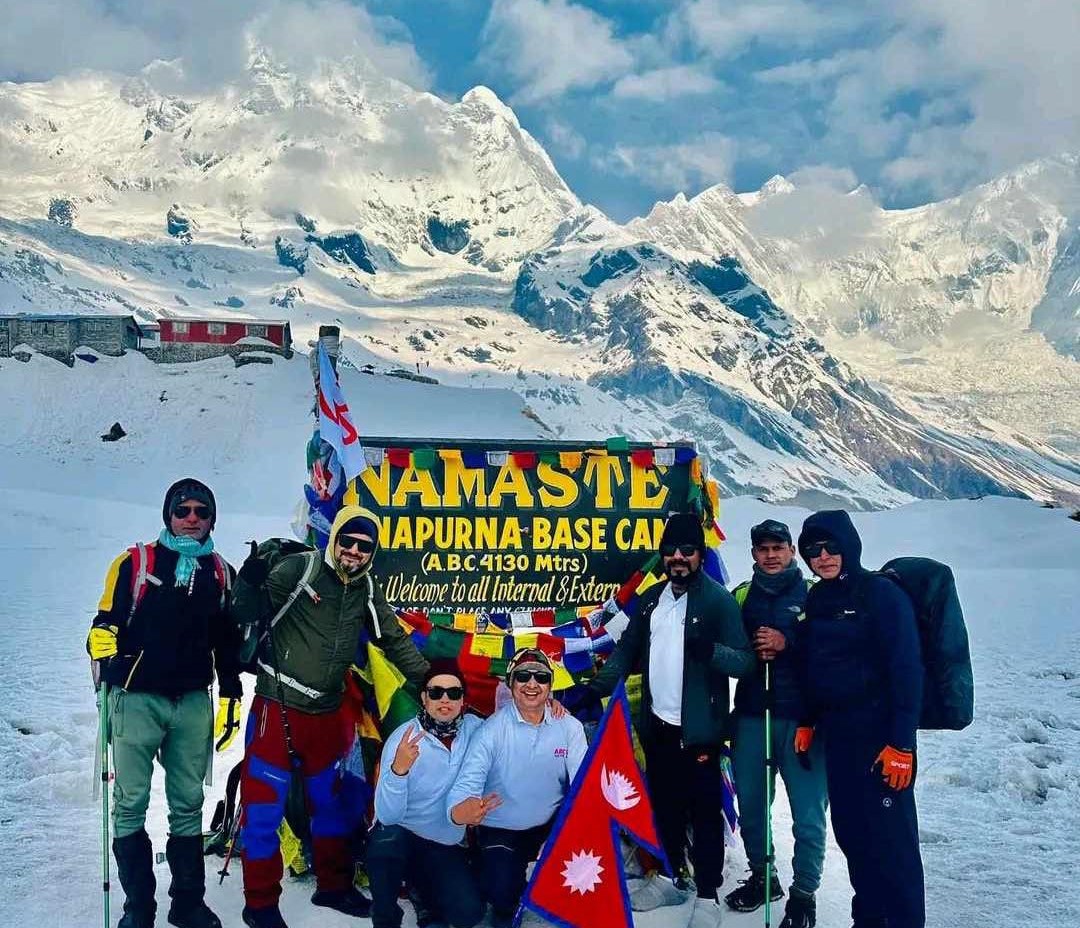Trip You May Like

Annapurna Base Camp via Ghorepani Trek

Upper Mustang Trekking

Everest Base Camp Trek

Langtang Trek via Gosainkunda Lake

Tamang Heritage Trail Trek

The Upper Dolpo trek offered by All Nepal Excursions is a 27-day adventure traversing through Nepal’s most remote region with high-altitude passes. The awe-inspiring natural landscapes, the Himalayas, and the Tibetan-influenced cultures and traditions of the local people blend the trek. The trek starts from Kathmandu with the scenic flight to Nepalgunj, followed by another scenic flight to Juphal. The trek will officially start from Juphal airport, which is one of the remote airports in Nepal. We will wind through the lush valleys and villages like Chhepka and Chunuwar, and then stroll to the stunning lake of Shey Phoksundo. This 3612m tall lake is framed by the marvellous peaks and monasteries nearby. A rest day near the lake allows us to have exploration to the Ringmo Village.
The journey further ascends to Sallaghari and Nagdalo La High Camp. We will cross the strenuous steep of the Nagdalo La Pass at staggering 5350m before reaching Shey Gompa. Shey Gompa is almost a thousand-year-old monastery, and we will have an acclimatization day here. The trail further passes through the villages of Komash, Shimen, Tinje, and others. We will descend back to Juphal via Nawarpani and Laisicap before boarding a flight to Nepalgunj.
This physically demanding trek reaches altitudes over 5000m. These high-altitude treks are challenging and physically demanding to a greater extent. However, this trek is equally rewarding when we look back on the adventurous ride.
This trek of 27 days to Upper Dolpo is amongst the most challenging compared to the other trails. This region of Dolpo falls under the Restricted Areas of Nepal, so not many have visited this trail before. The off-beaten path provides the most exhilarating Himalayan experience. This journey of 27 days offers Nepal’s remote locations, with the stunning and picturesque views from Shey Phokundo Lake and the high altitude pass of Nagdalo La Pass at a strenuous altitude of 5350m. We will get the chance to enjoy and explore the remote nomadic lifestyle of the Dolpo people with its cultural richness. This trek is a must-visit for those who are into such remotely high-altitude treks in Nepal, in the restricted area.
Spring (March-May)
Spring provides the mild temperatures and blooming rhododendron valleys in the lower valleys. The skies will be clear; hence the excellent views of peaks near the Dolpo region in the area. We will pass through the snow-lingered pass in Nagdalo Pass, but that is due to the altitude it has. The trails will be generally accessible due to a lower amount of rain. This season will be perfect to explore the natural beauty and culture.
Autumn (September-November)
Autumn provides fairly commendable and friendly weather conditions. We will have the finest of trails with the views that are magnificent. There will be very little chance of our trail being disturbed by the rain, so expect dry trails and stunning Himalayan vistas with the vibrance of culture in the villages. Festivals like Dashain and Tihar will also be approaching, making the village more vibrant and buzzing this season. These things make this season more unique and favourite.
The Upper Dolpo Trek is a strenuous and challenging 27-day journey through Nepal’s remote and high-altitude terrain. This trek demands better physical and mental conditions than the average. This trek required careful preparations to navigate successfully.
Permits Required
| Permit Type | Price for Non-SAARC Trekkers | Price for SAARC Trekkers | Notes |
| Lower Dolpo Restricted Area Entry Permit | $20 per person | $20 per person | Valid for the first week; must be extended for the same fee. |
| Shey-Phoksundo National Park Entry Permit | $30 per person | $30 per person | One-time fee for park entry |
| Upper Dolpo Restricted Area Entry Permit | $500 per person | $500 per person | Valid for the first 10 days, USD 50 per day for additional days |
Notes:
Altitude
The maximum elevation of this trek reaches up to 5350m in Nagdalo La Pass and starts with a minimum of 492m in Nepalgunj. This trek poses the risk of altitude sickness for the trekkers.
Acclimatization
Acclimatization is an adaptation process to reduced oxygen at higher altitudes. We have scheduled days for rest and acclimatization in Shey Phoksundo and Shey Gompa to adapt to the thinning air levels.
Precaution
The precautionary methods for this trek include gradual ascent and hydration with monitoring for altitude sickness symptoms. We will avoid the rapid climbs as much as possible and use the medications if necessary.
Basic Treatment
For the altitude sickness, we will have to descend immediately if the symptoms worsen. Adding oxygen levels and using Diamox for the mild cases will be necessary. We will rest, hydrate, and avoid alcoholic beverages during the trek.
Rescue
The Upper Dolpo trek has an option of emergency rescue due to remote terrain. We will coordinate with the local trekking agencies for emergency plans. We have to carry insurance plans that cover the high-altitude rescues.
Travel Insurance is very necessary during the treks to Upper Dolpo. As we travel the higher altitudes and remote terrains, there are lingering unforeseen risks. Medical Insurance should cover the high-altitude rescue and medical bills that can be hefty for your hard-earned money. Ensure that the coverage extends to 5350m and includes adventure activities. Always verify the policy details before buying the insurance. All Nepal Excursions will help in choosing the best travel insurance for you. Feel free to text us anytime.
The food during the trek will primarily be prepared by the camping crew at the campsites due to the remoteness of the trail. The food will be simple, hearty dishes like dal bhat, noodles, soups, pasta, French fries,Tibetan bread, and so on. Fresh vegetables will not be available during the high-altitude treks like this, so expect preserved or canned food. The city areas like Kathmandu and Nepalgunj will provide ample food options with a variety. We recommend that you carry snacks like energy bars and chocolates to sustain you on the longer trekking days.
Accommodations during the trek are very basic. Teahouses in Dunai and Dho Tarap offer basic beds and blankets with shared facilities. These teahouses often lack electricity and a heating system. We have to use our sleeping bags even if a blanket is provided. With just the basic pit toilets and no hot showers in the remote areas, Facilities are minimal and very basic. Trekkers should prepare for the rustic conditions and carry the appropriate gear for a comfortable trek.
The Upper Dolpo provides enriched additional activities beyond trekking and enhances the cultural and natural experience to a greater extent. We will not only have the adventurous journey towards the remote wilderness of Dolpo, but also have these activities as add-ons and options:
We will land at Tribhuwan International Airport in Kathmandu. Kathmandu offers its unique vibrance of buzz and culture. One of our staff members will welcome you, and you will be directly transferred to the hotel. After getting relaxed, you will meet your guide and we will have our last-minute preparations for the trek ahead wuth the final briefing in the hotel.
We will fly to the city of Nepalgunj, which is elevated to just 492m in Nepal’s western terai region. The city serves as a transit for the remote treks like those of Dolpo. We will stroll around Nepalgunj today and acclimate to the warmer climate before catching the flight to Juphal.
We will have a steep ascent alongside the Bheri River from Dunai to Chhepka today. The trail will pass through the pine forests, traditional villages with terraced fields. We will cross the tall suspension bridges and enjoy the mystic landscape of the Himalayas. Chhepka is a small settlement that offers a peaceful campsite on the scenery. We will have a camp setting and spend the night here.
We have tentatively five hours of trek till we reach Chunuwar.. We will reach Amchi Hospital, which is a center for traditional Tibetan medicine. This trail will ascend gradually through the forests and the Phksundo River. We will stay overnight in Chunuwar.
It normally takes 4-5 hours of trek to reach Phoksundo Lake from Chunuwar. Shey Phoksundo is a naturally formed lake with picturesque views from the place. The trail will climb through the cedar forests and provide exhilarating views everywhere. We will spend a night under the pristine beauty of Shey Phoksundo.
Today is our rest day at Phoksundo Lake. We will have more time to spend around the beautiful and pristine views from the lake. We will visit the local monasteries and take short hikes to nearby hills to enjoy the stunning scenery. The rest day also allows us to have freshen ourselves in the stunning scenery of Upper Dolpo.
The generic time to complete this section to Sallaghari to Phoksundo Lake is about 5 hours. This stroll allows us to enjoy the panoramic views before ascending through the open meadows. Sallaghari is a scenic campsite that provides a peaceful retreat from the higher altitude.
The strenuous pass of Nagdalo La pass at the stranded height of 5350m is a steep ascent and descent for about 7 hours. We will cross this pass against the thin air, rewarded by the remote wilderness of Upper Dolpo. The serene valley of Shey Gompa awaits us.
We will have a stroll towards Namgung Gompa for about 5-6 hours today. We will also cross the Sela La Pass at a staggering 5094m. The trail winds through the barren landscapes and high plateaus. The campsite will be formed around Namgung Gompa to spend the night.
We will trek for about 5 hours till we descend towards Saldang. Saldang is one of Dolpa’s largest settlements. The day will be full of cultural and natural immersion with the locals. The Tibetan-Influenced culture and vibrant community with the colourful houses and monasteries will offer a glimpse into the daily life of Upper Dolpo’s people.
Yanjer Gompa is amongst the most significant and oldest monasteries on this region. It will take around 4-5 hours of round-trip time to complete the exploration of ancient artifacts and stunning valley views. We return to Saldang for the night while we enjoy the cultural richness.
The trek from Saldang to Komash takes us 6 hours to complete. The trail ascends through the barren hills and remote valleys that offer glimpses of nomadic yak herders and traditional Dolpo life. Komash is a small village that provides the best campsite, which is surrounded by remote and stark landscapes.
We will trek to Shimen for about 6 hours. The steep descent through the rocky terrain and sparse vegetation might get challenging with the time being. We will pass small settlements and ancient chortens. Shimen gives a glimpse of the remote lifestyle of the Dolpali people. We will sleep in the village of Shimen.
The trail from Shimengaon to Tinjegaon follows the Panjyang River that passes through remote villages and open valleys. Tinje is a vibrant and culturally immersive village with small settlement. The serene setting and warm hospitality make this place an ideal stopover. We will stop and enjoy the surroundings of Tinjegaon overnight.
The trail today is a gentle ascent from Yak Kharka to Tokyu. This trail goes through the barren landscapes and high plateaus. Tokyu is a vibrant village with a monastery that showcases the rich Buddhist heritage. We will stay overnight at Tokyu.
We will have a gentle descent from Tokyu to Tarap today. We will pass through the valleys that are wide open alongside ancient villages. Dho Tarap is a cultural hub with its monasteries and schools. This is where we will spend the night amidst the stunning Himalayan scenery.
We will have a stroll descending to Laisicap today. The trail continues descending alongside the river that passes through the pine forests and small villages. Laisicap is a quiet settlement that provides a serene campsite with magnificent views of the local hills.
We will have a short ascent of 2-3 hours to Juphal from Dunai today to end our trekking journey. We pass through the scenic villages and fields. We will arrive in Juphal, where we have to board a flight to Nepalgunj tomorrow morning to close things off.
This is the last of our trips in Nepal. We have an early morning flight towards Nepalgunj from Juphal. Our next board will be from Nepalgunj to Kathmandu after lunch. After arriving in Kathmandu, we will have a celebration dinner marking the end of this beautifully crafted and adventurous treks.
In the flight timing, we will have a final shopping and stroll around Thamel. As we head towards the airport for the farewell, we will reflect on the adventure and find strength, and have a lot of stories to tell. We hope you arrive in Nepal next time as well. This day marks the end of our memorable trek in Upper Dolpo, full of cultural and natural immersion.
Equipment & Gear for Trekking in Upper Dolpa Trek:
Before embarking on a trek to Upper Dolpa Trek, it is essential to pack the necessary gear and equipment. Here is a checklist of essential trekking gear you should take with you:
Clothing:
Footwear:
Backpack:
Sleeping and Shelter:
Electronics:
Others:
It is important to note that this checklist may vary depending on the weather conditions, trekking route, and personal preferences. It is advisable to pack light and carry only the essential items to make your trek comfortable and hassle-free.







